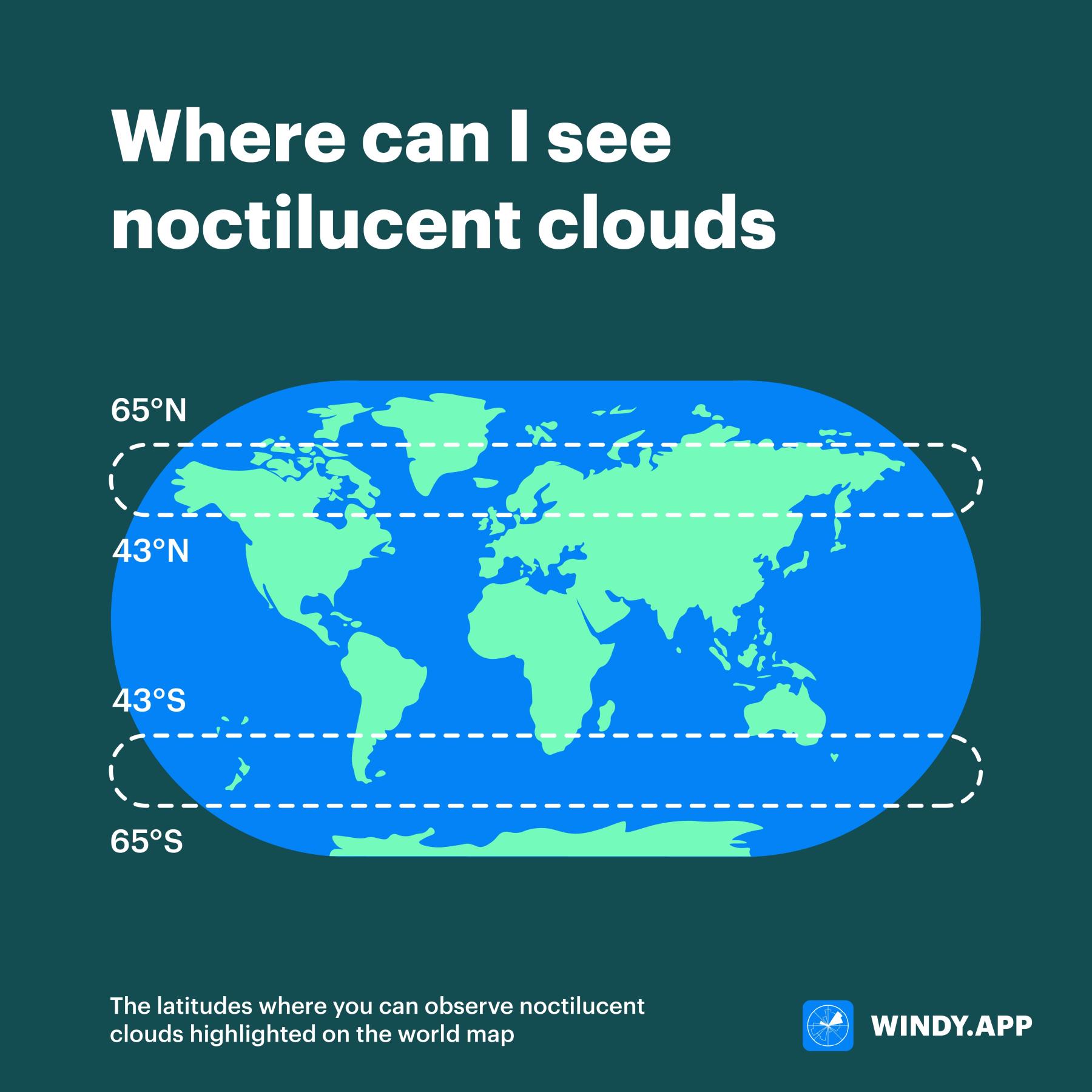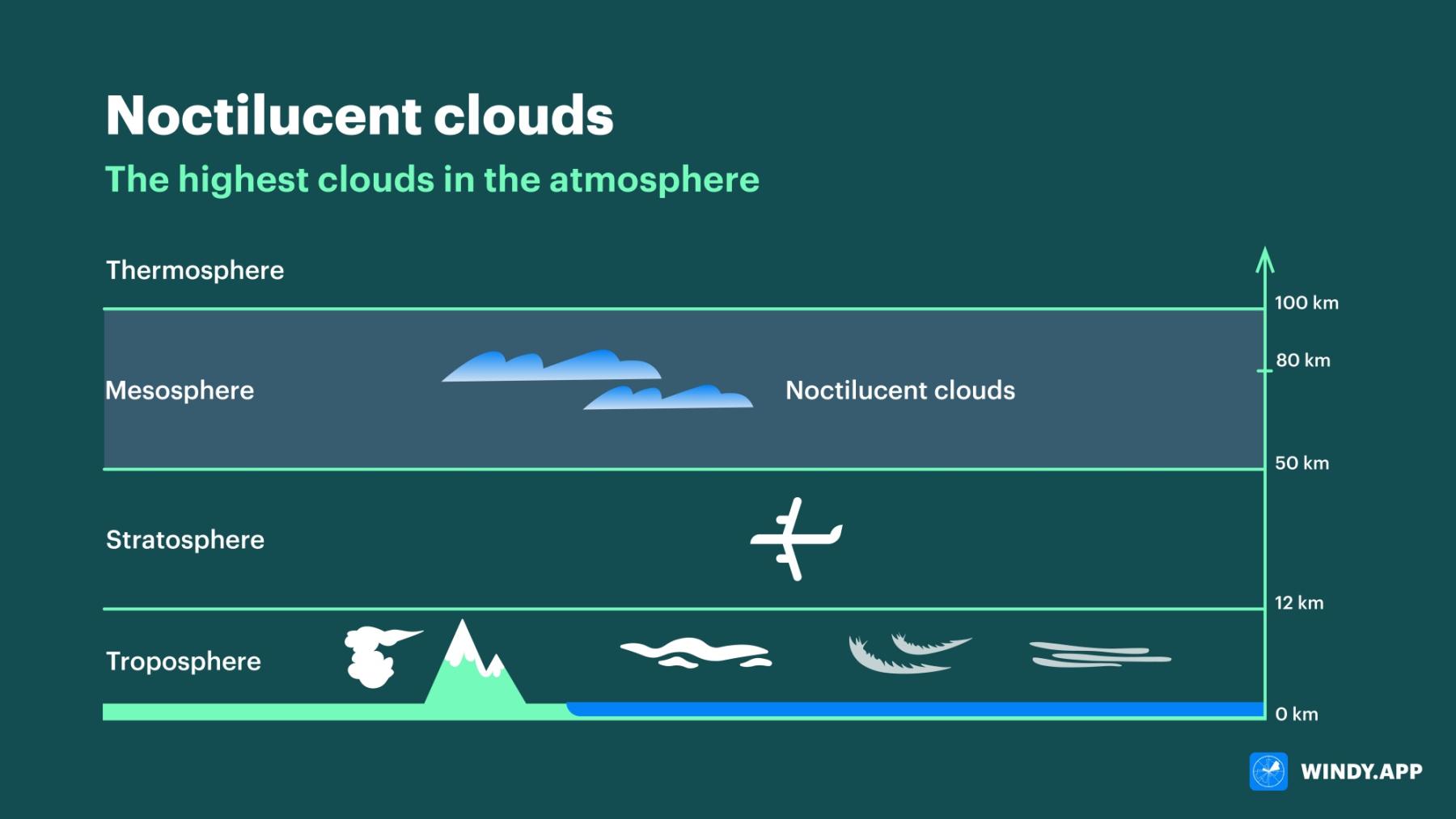
How do night-glowing clouds form
Noctilucent clouds (night-glowing clouds) on the photo are rare atmospheric phenomenon that occurs after sunset or before sunrise. In this new lesson of the Windy.app Meteorological Textbook (WMT) and newsletter for better weather forecasting you will learn more about what Noctilucent clouds is.
When and where can I see noctilucent clouds?
Noctilucent clouds appear in the sky only at night and only in warm seasons. In the Northern Hemisphere they appear from May to September, and in the Southern Hemisphere — from November to March.
This phenomenon can be observed by those who live in the strip between 43° and 65° of northern or southern latitude.
This is almost the entire Europe, part of Asia, countries such as the United States, Canada, a small part of Argentina and Chile, Australia and New Zealand.

The latitudes where you can observe noctilucent clouds highlighted on the world map. Illustration: Valerya Milovanova / Windy.app
The highest clouds
Noctilucent clouds are the highest clouds in the atmosphere! They are formed at an altitude of about 80 km, i.e. in the upper part of the mesosphere.

The mesosphere is the third layer of the atmosphere from the Earth’s surface, located at the altitudes of 50-90 km. Illustration: Valerya Milovanova / Windy.app
Why do we only see them at night?
It is more correct to say, at dusk. Noctilucent clouds are only visible when the sun is beyond the horizon and is 6-16° below the horizon.
Therefore, look for these clouds in the sky between sunset and total darkness. Or, on the contrary, before sunrise.
.png)
Noctilucent clouds
At this time, the lower layers of the atmosphere are in the shadows, and thus can be seen dark against the background of dawn. It is by this feature that you can distinguish noctilucent clouds from all others.
Noctilucent clouds look as if glowing because the setting sun can only illuminate objects at high altitude.
It is when the sun goes down for a short time and not far beyond the horizon that you can observe objects in the mesosphere.
This is why the shortest nights of the year are best suited for observation of noctilucent clouds. There are several weeks for each latitude when these clouds are visible most often.
How do noctilucent clouds appear?
At first, it was presumed that these clouds consist of volcanic dust, then — of dust from meteors or meteorites. Now we know that the clouds themselves consist of ice crystals.
However, scientists still do not know exactly how noctilucent clouds are formed. Almost all water vapor from which clouds form is in the lower layers of the atmosphere.
So how can there be enough water vapor from which clouds form at such a high altitude? Scientists are still just making hypotheses.
What hypotheses are being put forward?
According to one of them, in the middle latitudes in summer, at an altitude of 25-30 kilometers, upward air flows are formed. They carry water vapor into the upper mesosphere. There, the steam freezes and forms noctilucent clouds.
Another hypothesis is that water vapor (H2O) at these altitudes is formed by the interaction of hydrogen atoms (H2) flying from the Sun to the Earth with oxygen atoms (O2) in the mesosphere. The hypothesis is called ’solar rain’.
According to another hypothesis, water vapor is supplied to the upper part of the mesosphere by mini-komets. There are other hypotheses, but still, none has any confirmation.
Text: Windy.app team
Illustrations: Valerya Milovanova, an illustrator with a degree from the British Higher School of Art an Design (BHSAD) of Universal University
Cover photo: Unsplash
You will also find useful
Latest News
Professional Weather App
Get a detailed online 10 day weather forecast, live worldwide wind map and local weather reports from the most accurate weather models.
Compare spot conditions, ask locals in the app chat, discover meteo lessons, and share your experience in our Windy.app Community.
Be sure with Windy.app.



